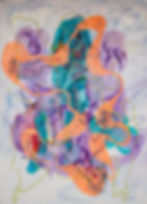

Amanda Shingirai Mushate’s paintings resemble maps, where fluid lines and vibrant color blocks unfold into complex universes. As she explains, they are emotional landscapes, charting her past, present, and imagined future. Their fluidity and sensitive rhythm also convey a distinctly female experience, while for the artist painting is a way of following music, rhythm, and flow—her brushstrokes moving fast or slow, in tune with the song.
How do you feel about experimentation?
Experimentation is essential. It’s like an adventure—sometimes scary, especially when materials are expensive, but always worth it. It helps me grow, find my flow, and keep evolving. I don’t want to be the same artist I was three years ago; the world is moving, and I want my practice to move with it.
Your paintings have such a strong sense of fluidity—flowing lines, layered motifs. It feels like being in a flow state. How do you think about that feeling in your work?
Music drives my painting. It brings back memories—some joyful, some painful—that turn into rhythm and movement on the canvas. My flowing lines reflect life’s shifts: friendships gained and lost, paths that diverge. They carry both loss and growth, always moving forward. My lines and fluid motifs reflect those journeys, those flows of life, those changes in relationships
How did you decide that your journey would be to become an artist?
I grew up in Bulawayo, where art was always part of me. I often competed with my brother—he was the brilliant student, while I felt left out. He also acted as a father figure, strict but protective, since we were raised by a single mom. Deep down I knew I had something to give, so I poured my energy into art. My mother supported me in everything—even taking me to theatre and later to art school. I once considered nursing, like many of my friends, but that was peer pressure, trying to be someone I wasn’t. But my mother took me to an art school, and that made me realize I couldn’t deny what was inside me. Art was where I truly belonged.

Many artists begin with figurative work and then shift to abstraction later. But you are an abstract artist from the beginning. Did you make a conscious decision, or did it just happen?
It’s a bit of both—I decided, but it also happened naturally. I’ve always wanted to express myself, but sometimes it’s better to communicate indirectly. Abstraction allows me to share something important without confronting the viewer too directly. If I painted very raw or provocative stories realistically, it might feel heavy or even hurtful. With abstraction, I can express emotions while keeping the viewer comfortable and open.
My public works are playful, full of “candy colors,” reflecting life’s mix of joy and struggle in a light, inviting way. I want my paintings to carry a sense of childlike play, even when the themes are serious. Realism doesn’t excite me—abstraction does. It lets me follow music, rhythm, and flow, with brushstrokes that move fast or slow depending on the song.
Your compositions remind me of maps—almost like emotional cartographies. Are you thinking of them as physical maps, or more as emotional ones?
They’re emotional maps. I’m painting myself—my past, my journey, and even the future I imagine for my child. I may not achieve everything I dream of, but through my work I can lay foundations for her. The past shapes tomorrow, even when we’d rather erase it. Memories of Bulawayo, Victoria Falls, and my mother’s constant moving are woven into my art. Migration, displacement, and the loneliness of starting over all echo in my work—like learning to crawl, stand, and walk again in a new place.
So it’s a mapping of past, roots, and also hopes for the future?
Exactly. That’s why I work with many layers—thin washes, textured grounds, plain surfaces—so the viewer can walk through the painting, like moving through a landscape. My work is full of probabilities, of “what ifs.” Sometimes the lines even take shape as human figures or animals. It’s another reminder that we’re all connected—humans, animals, the city, the landscape. Everything flows together.
How do you begin a painting, and how do you build up the layers?
My process shifts with my mood, but usually I begin with a thick layer, then cover it with glue stick or paper—like uncovering hidden truths. After that I apply a wash, and that’s when the painting starts to take shape. The most important stage comes after the wash. That’s when the work begins to speak back to me. Sometimes I can guide it, but often it takes control.
I work slowly with oils, moving between several canvases at once. Ink and gloss give shine to the backgrounds, while layers build depth. I love the intimacy of small brushes, almost like conversing with the canvas, and I sometimes add oil sticks for a more graphic contrast. That tension between painterly and graphic marks creates another rhythm in the work.

I feel that women often interpret life differently. For men, it can feel like a straight line—beginning, middle, end. But for women, life feels more like a labyrinth or a fluid loop. How do you see the female experience in relation to your art?
As women, we often take things too seriously, always striving for perfection. A small mistake can overwhelm us, and I try to resist that. In some ways, I envy how men can just move on. The art world here is male-dominated, so I’m proud to stand as a woman within it, bringing a softer, more open approach—letting things come and dealing with them as they arrive.
What are the biggest challenges of being a female artist in Zimbabwe today?
At first, I was judged—especially outside the art world. People asked why a woman would choose this path, and when I worked in stone sculpture, boys would joke about how I managed heavy stones. It showed me how male-dominated the field was. I was lucky to find mentors early, but it’s still tough for women, especially if they have children before reaching their goals. At the same time, I’ve had many opportunities and strong support—from women who paved the way like Virginia Chihota and Portia Zvavahera, to advocates like Valerie Kabov, and even supportive male artists. The road is challenging, but I’m grateful for the community around me.

How did motherhood change your style, your thoughts on art, or even your career?
Before 2019, my work was mostly about myself and my friends. I was inspired by life in Harare—how busy and energetic the city is, especially compared to Bulawayo where I grew up. Harare women carry themselves with such power and presence, and that energy inspired me. My paintings were about being strong, independent, doing my own thing, and not letting anyone else define me.
After giving birth, everything changed—my body, my rhythms, my art. Being called “mama” is pure bliss, but children don’t just need care, they need your constant attention. It’s exhausting at times, yet deeply joyful. My daughter is my guide and angel, and motherhood has transformed my priorities, my practice, and my life.
How do you balance your different roles—being a wife, a mother, and an artist? And how do you and your husband inspire each other in your work?
With Tashi (Tashinga Majiri - ed.), we are more friends than partners—friendship always comes first, whether it’s about work, home, or life. He’s into writing and reading, while I love documentaries and films, so we often exchange what we’ve discovered. Those little exchanges feed into our art and even into the way we live day to day. We also share a studio, though our rhythms are very different. That difference creates balance, and it’s what keeps us connected.
As artists, it feels special to share life with someone who truly understands the frustrations and the joys of the creative process. When things don’t go as planned, having a partner who knows what that feels like is invaluable. Our works influence each other too—sometimes unconsciously, in the way fluid lines or colors echo across both canvases. We often laugh about it, because inspiration seeps in without us even realizing. And then there are the critiques: if he says a painting isn’t working, I trust his judgment, because I know others will probably see the same. Sometimes I lose myself in a piece, go too deep, and he’s the one who pulls me back, reminding me to take my time.
We are husband and wife, but more importantly collaborators and friends. That shared balance—living together, working together, inspiring and grounding each other—is what keeps our practice alive.

How do you choose your colors?
Color is deeply personal for me. Since childhood I’ve loved purple, green, and gray—though friends joked they weren’t “girlish.” Green feels like life, fresh and connected to nature, while blue is spiritual and full of aspiration. Pink grew stronger in my work after my daughter was born—her world is all pink! I also use yellow, peach, and other bright tones for warmth and vitality, often thinking of the Zimbabwean flag. And brown—my skin, my hair, my identity. In a way, all my colors are self-portraits, each carrying its own story, memory, and emotion.
In Europe, there’s a lot of talk about the Black Art movement, and African artists are more in the spotlight than before. From your perspective here, how do you see that?
For me, art is just art. It’s expression. I don’t see the need for titles like Black art or White art. Everyone is simply expressing themselves in different ways. I’d describe myself as a colorful person. I love color, I’m loud, and I have a childlike side that I cherish. At the same time, I’m a mother, I’m growing, I’m playing, I’m learning. I don’t take everything too seriously, but I also carry my own burdens. So when I express myself in art, I’m expressing all of that at once.

What are your current plans?
Right now I’m focusing on sculpture. I don’t create for shows—I prefer to work honestly, take my time, and let exhibitions come when the work is ready. I’m experimenting with larger sculptures and installations, while still painting occasionally. Sculpture feels different: slower, more meditative. I listen to documentaries and interviews—musicians like Nicki Minaj, Fela Kuti, Oliver Mtukudzi—because for me it’s about human interaction, how people think and describe themselves. Sculpture is a way of learning about myself before telling others who I am.







